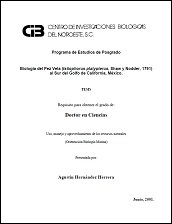Efecto de la frecuencia alimenticia en el crecimiento y sobrevivencia de juveniles de langosta de agua dulce Cherax quadricarinatus (von Martens, 1868) (Decapoda: Parastacidae)
Effect of feeding frequency on growth and survival of juvenile crayfish Cherax quadricarinatus (von Martens, 1868) (Decapoda: Parastacidae)
Autor
EDILMAR CORTES JACINTO
HUMBERTO VILLARREAL COLMENARES
Metadatos
Mostrar el registro completo del ítemResumen
"El efecto de la frecuencia alimenticia en el crecimiento y sobrevivencia de juveniles de langosta de agua dulce Cherax quadricarinatus, fue evaluado en 60 días de cultivo. Grupos de juveniles de acociles (crayfish) con peso inicial de 0.89 ± 0.06 g fueron alimentados con cuatro diferentes frecuencias de alimentación por día: cada 24 h (C1), 12 h (C2), 6 h (C3) y cuatro veces al día (C4) con una dieta con 35% de proteína cruda. Las tasas de crecimiento específico (TCE) de 3.02 y 2.79%/día, muestran que las frecuencias alimenticias C3 y C4 maximizan el desarrollo de juveniles de C. quadricarinatus, obteniendo pesos finales de 4.7 y 5.4 g, biomasas de 253.2 y 311.8 g/m2 , con Factores de Conversión Alimenticia (FCA) de 1.8 y 1.2, respectivamente. Los tratamientos C1 y C2 mostraron un FCA significativamente más alto. El intervalo de sobrevivencia fue de 86.7 a 98.3%, siendo estadísticamente menor para los tratamientos experimentales C1 y C2. Los resultados de incremento en peso de los juveniles de C. quadricarinatus, indican que la frecuencia de alimentación óptima es de al menos tres veces al día. Sin embargo, en términos de biomasa final el tratamiento C4 fue significativamente diferente con respecto a los demás tratamientos. La información obtenida contribuirá a mejorar la comprensión de la dinámica de distribución del alimento y correlacionarla con la condición nutricional y rendimiento en la producción de juveniles de C. quadricarinatus." "The effect of feeding frequency on the growth and survival of juvenile freshwater crayfish Cherax quadricarinatus with initial mean weight of 0.89 ± 0.06 g was evaluated in a 60-day study. Juveniles were fed with four different feeding frequencies: every 24 h (C1), 12 h (C2), 6 h (C3) and 4 h (C4), with a 35% crude protein diet. Specific Growth Rates (SGR) of 3.02 and 2.79%/day showed that feeding frequency treatments C3 and C4 maximize growth of juvenile C. quadricarinatus, reaching final mean weights of 4.7 and 5.4 g, biomasses of 253.2 and 311.8/m2 , and Feed Conversion Ratios (FCR's) of 1.8 and 1.2, respectively. Treatments, C1 and C2 showed significantly higher FCR’s. Survival ranged from 86.7 to 98.3%, and was statistically different among the experimental treatments, except for organisms fed with C1 and C2. Final weights of juvenile C. quadricarinatus showed that a feeding frequency of at least three times a day (C3) was significantly better. However, in terms of biomass, treatment C4 was better. The information obtained will contribute to improve the understanding of the dynamics of distribution of feeds and to correlate it with the nutritional condition of juvenile C. quadricarinatus."
Colecciones
Ítems relacionados
Mostrando ítems relacionados por Título, autor o materia.
-
PROMOCIÓN DEL PERIFITON PARA EL CULTIVO DE CAMARÓN BLANCO: HACIA UNA ACUICULTURA ECOLÓGICA
DOMENICO VOLTOLINA LOBINA; JUAN MANUEL AUDELO NARANJO; MARIA DEL ROSARIO PACHECO MARGES -
Suelo y Erosión
YOLANDA LOURDES MAYA DELGADO


